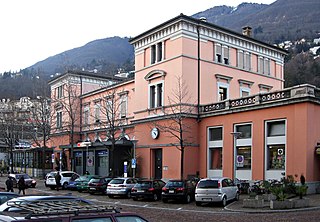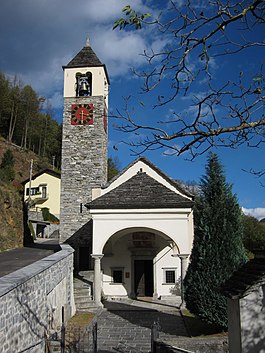
Ticino, sometimes Tessin, officially the Republic and Canton of Ticino or less formally the Canton of Ticino, is one of the 26 cantons forming the Swiss Confederation. It is composed of eight districts and its capital city is Bellinzona. It is also traditionally divided into the Sopraceneri and the Sottoceneri, respectively north and south of Monte Ceneri. Red and blue are the colours of its flag.
The Regional Bus and Rail Company of Ticino is a limited company in the Swiss southern canton of Ticino, which provides the urban and suburban bus network in and around Locarno in Switzerland. It operates the cable cars between Verdasio and Rasa, Ticino, and between Intragna – Pila – Costa on behalf of the owning companies. Together with the Italian company Società Subalpina Imprese Ferroviarie (SSIF) they operate the railway through the Swiss Centovalli and the Italian Valle Vigezzo, which connects the Gotthard trans-Alpine rail route at Locarno railway station with the Simplon trans-Alpine route at Domodossola in Italy. There are 10 stations on the Swiss side of the frontier and 12 stations on the Italian side, the complete rail journey takes about 1 hour and 45 minutes.

Locarno is a southern Swiss town and municipality in the district Locarno, located on the northern shore of Lake Maggiore at its northeastern tip in the canton of Ticino at the southern foot of the Swiss Alps. It has a population of about 16,000 (proper), and about 56,000 for the agglomeration of the same name including Ascona besides other municipalities.

There are 106 municipalities in the canton of Ticino, Switzerland,. Municipalities (comuni) are grouped in circles (circoli) which are part of districts (distretti).

Intragna is a village and locality in the municipality of Centovalli in the district of Locarno of the canton of Ticino in Switzerland.

Santa Maria Maggiore is a comune (municipality) in the Province of Verbano-Cusio-Ossola in the Italian region Piedmont, in Valle Vigezzo, located about 130 kilometres (81 mi) northeast of Turin and about 25 kilometres (16 mi) north of Verbania, on the border with Switzerland. As of 31 December 2004, it had a population of 1,236 and an area of 53.2 square kilometres (20.5 sq mi).
The Locarno District is a district of Canton Ticino, Switzerland. It has a population of 63,774.

Borgnone is a hamlet part of the municipality of Centovalli in the district of Locarno in the canton of Ticino in Switzerland. Not to be confused with much bigger Camedo or with Lionza or Costa.

Palagnedra is a village and a locality part of the municipality of Centovalli in the district of Locarno in the canton of Ticino in Switzerland. Lago di Palagnedra is located below the village, on the Melezza river.

Valle Vigezzo is a valley in the Lepontine Alps in northwestern Italy on the border with Canton Ticino of Switzerland. It forms the eastern branch of the Ossola valley. It is also called the Valle dei Pittori due to the large number of painters over the centuries such as Giuseppe Mattia Borgnis, Lorenzo Peretti, Bernardino Peretti, Enrico Cavalli, Carlo Fornara, Giovanni Battista Ciolina, Gian Maria Rastellini, Maurizio Borgnis, Lorenzo Peretti Junior. It is remembered for its "spazzacamini" or chimney-sweepers who brought their trade around Europe. It is connected with the Eau de Cologne, invented over 300 years ago by Giovanni Maria Farina using, among other ingredients flowers and oils from plants from Vigezzo. Another man from Vigezzo, Giovan Maria Salati is credited to be the first recorded person swimming across the English Channel over 200 years ago, after having been taken prisoner by the British after Waterloo.

The Melezza, in Italy the Melezzo Orientale, is a 42 km Alpine torrent which runs through the eastern part of the Val Vigezzo, in the Province of Verbano Cusio Ossola, northern Italy; and through the Centovalli of Canton Ticino, Switzerland. Belonging to the Po basin, it is a tributary of the Maggia which in its turn flows into Lago Maggiore.

Centovalli is a valley and a municipality in the district of Locarno in the canton of Ticino in Switzerland. It is composed of 19 villages or hamlets "frazioni". The municipality was formed on 25 October 2009 through the merger of the municipalities of Borgnone, Intragna and Palagnedra.

Locarno railway station serves the city of Locarno, in the canton of Ticino, Switzerland. However, the station is located within the adjacent municipality of Muralto, near the shore of Lake Maggiore. The border between the two municipalities runs along the Torrente Ramogna stream, a short distance to the south and west of the station.

The Domodossola–Locarno railway line, informally called the Centovallina in Switzerland and the Vigezzina in Italy, is a metre-gauge railway negotiating the dramatic mountainous terrain between Domodossola, Italy, and Locarno, Switzerland. It passes through the Vigezzo Valley and Centovalli.

Terre di Pedemonte is a municipality in the district of Locarno in the canton of Ticino in Switzerland. The municipalities of Cavigliano, Tegna and Verscio merged on 14 April 2013 into the new municipality of Terre di Pedemonte.

The border between the modern states of Switzerland and Italy extends for 744 kilometres (462 mi), from the French-Swiss-Italian tripoint at Mont Dolent in the west to the Austrian-Swiss-Italian tripoint near Piz Lad in the east. Much of the border runs across the High Alps, rising above 4,600 metres (15,100 ft) as it passes east of Dufourspitze, but it also descends to the lowest point in Switzerland as it passes Lago Maggiore at below 200 metres (660 ft).
CoEur is a Christian devotional and hiking route in Italy and Switzerland. Its Italian subtitle, Nel cuore dei cammini d'Europa, translates as "In the heart of Europe's paths".
The so-called Market way connects Locarno with Domodossola, through the Centovalli and the Val Vigezzo. The way uses ancient path and mule tracks used in the past centuries by merchants transporting goods from Italy and Switzerland. In the early 20th century the Centovalli railway was built in order to develop the commerce and is nowadays a main tourist attraction.

Locarno FART railway station is a railway station that serves the city of Locarno, in the Swiss canton of Ticino. It is the Swiss terminus of the cross-border metre gauge railway line from Domodossola in Italy, which opened in 1923. Until 1990 these trains terminated in the forecourt of the mainline station, after passing through the streets of Locarno. This was replaced by a new underground station and section of line.

Bagni di Craveggia is a frazione of the municipality of Craveggia, in Piedmont, northern Italy. It is located in Valle Onsernone at 986 m (3,235 ft), on the border with the Swiss municipality of Onsernone via the village of Comologno and is crossed by the Isorno river. It owes its name to a source of thermal water at 28 °C (82 °F).




















